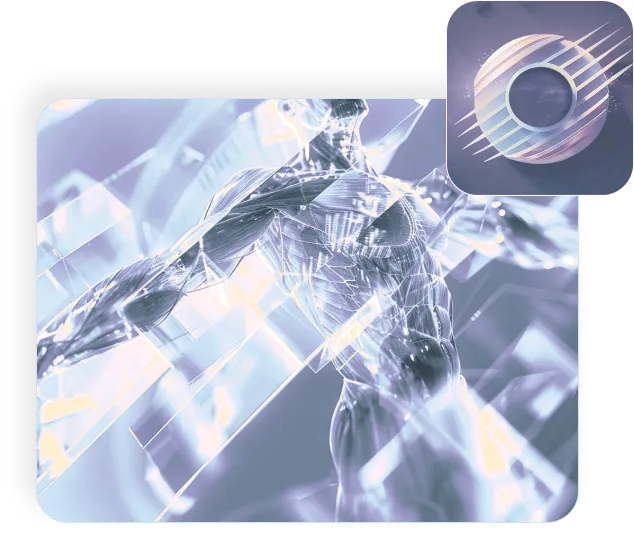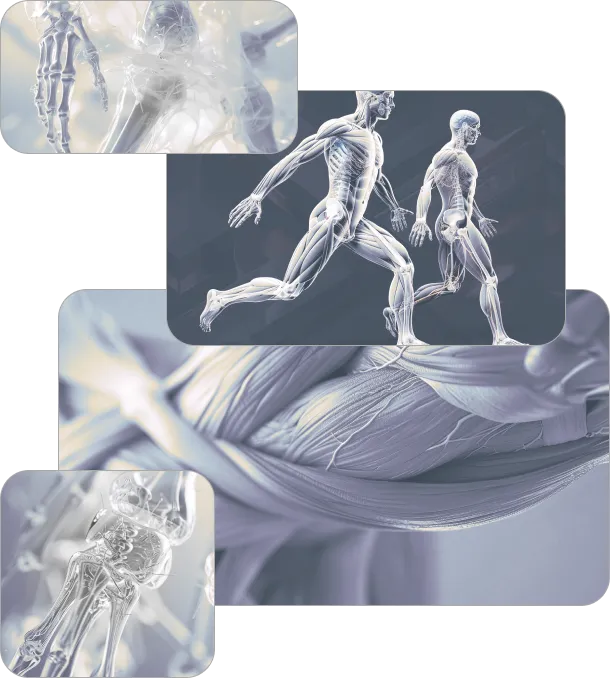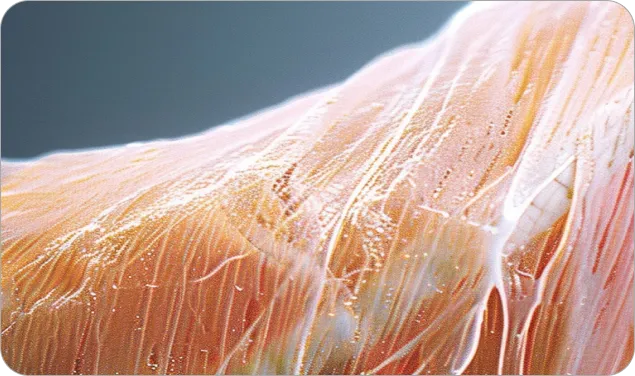
FASCIA FLOW ONLINE COURSE
Fortify your body.
Free your mind.
Learn how to condition your fascia so you can stay strong and agile in every way.

Reduce joint and muscle pain

Decrease recovery time

Perform better under
pressure

Reduce joint and muscle pain

Decrease recovery time

Perform better under
pressure

What exactly is fascia?
Fascia is a collagen-based, triple-helix, metaphasic, polymorphic, piezoelectric, viscoelastic tissue.
That sounds super complicated, but here's the basic idea:
Imagine three straws of the tiniest diameter, braided together, filled with and surrounded by fluid.
The straws change shape and consistency based on the force pressed on them and the electrical frequency moving through them.
Bands of the braided straws are arranged in layers and are wrapped around every part of your body: your organs, muscles, bones, joints, blood vessels, and nervous system
That's fascia! In some parts of the body, it's thin and resembles spider webs. In other places, it's more like a dense fabric made of thick rubber bands.
Now let's talk about why you should care...
Fascia, mobility, and the mind.
When the fascia is healthy, it produces hyaluronic acid, which allows muscles and other tissues to easily expand, contract, and glide across one another. Healthy fascia also enables the current of the nervous system to operate optimally.
But when the fascia is unhealthy, hyaluronic acid production slows and the tissues become adhered to one another. This can cause pain, limit mobility, inhibit nerve function. And our brain, which is in constant communication with our body, experiences fascia adhesions as tension—which ultimately hampers cognition and creativity.

Unhealthy fascia

Healthy fascia
Learn to correct and prevent fascia adhesions.
Deep Fascia Conditioning offers a gentle approach that takes just 20 minutes a day.

Fascia Adhesions
Find out what causes fascia adhesions, how to identify them, and what to do about them.

Fascia Map
Learn where the fascia bands sit in the body and how they're connected with one another.

Fascia Rulebook
Discover a compression-based technique that promotes hyaluronic acid production and gently releases fascia adhesions.
Customer testimonials
We are proud of the people we help.

Brooke McPoyle
Founder of Musical Breathwork
I needed my body to work.
As a D1 collegiate golfer, I nearly wrecked my body.
I didn't know it at the time, but I was heavily relying on my fascia to help me generate the torque required to send a golfball hundreds of yards down a fairway—over and over and over again.
And because I wasn't properly caring for those specialized tissues, I spent a lot of time nursing injuries. By the time I was 30, I'd dealt with chronic wrist issues, severely limited mobility, and a third-degree tear in my quad that sidelined me from elite athletics as an adult.
But I wasn't content to just "oh well" myself into old age.
Instead, I dove deep into anatomy and physiology, looking for clues to heal my body. That's when I came across Tom Myer's Anatomy Train and began developing a technique to restore my fascia to its optimum condition.
I've now formally introduced my technique to hundreds of athletes and artists. I can't wait to introduce it to you, too.
HOW FASCIA FLOW IS DIFFERENT
Condition the fascia, don't tear it.
Condition the fascia,
don't tear it.
Traditional Fascia Release Techniques
Traditional
Fascia Release Techniques
Based on outdated science that's 100+ years old
Manually removes adhesions by tearing the fibers
Requires a therapist or expensive equipment
Addresses only the immediate pain point
Treats only superficial fascia layers
Musical Breathwork's Fascia Flow
Grounded in modern science
Naturally releases adhesions through gentle compression
Effective with only a tennis ball and yoga block or large book
Starts from the ground up to address the root cause of pain
Reaches the deepest layer of tissue
Leverages nose-breathing to help reshape nasal glands for maximum benefit
I'll be with you the whole way.
1
2
3
4
Know you're doing it right with
step-by-step guidance.
Go at your own pace with bite
-size lessons (160 minutes total).
Learn whenever, wherever
with on-demand videos.
Come back again and
again with a course that never
expires.
1
2
3
4
Know you're doing it right with step-by-step guidance.
Go at your own pace with bite-size lessons (160 minutes total).
Learn whenever, wherever with on-demand videos.
Come back again and again with a course that never expires.
Common Questions
Find answers to your questions and discover how the powerful combination of breathwork and music can transform your well-being.
When you say fascia, what part of the body are you talking about?
Thanks to research presented at the international Fascia Research Congress, medical professionals are exploring how to better understand how fascia works and how it can be treated.
Previously known as “connective tissue” or interstitium, the fascia has been inappropriately described as the plastic wrapping around the muscles. This is only partially true.
Fascia is a triple helix collagen fiber network that moves fluid through it and around it. This tissue wraps not only every bone, joint, ligament, muscle, but it also goes over every muscle fiber we have. It’s the scaffolding of the body, with layers of almost industrial strength rubber bands to soft, almost mycelium (or cotton) textures. The fascia goes into the cells through integrins and helps our mitochondria move outside of the cell.
I know it sounds complicated, but don’t worry! In my courses and membership, I outline the basis of its structure in plain language. You’ll access visuals, diagrams, and models that explain the fascia’s polymorphic, viscoelastic, metaphasic, and piezoelectric qualities that are confusing researchers so much.
What’s important for you to know right now is this: Ensuring fascia flow is essential to our brain, our breath, our nervous system, our cell function, our joint longevity, our electromagnetic capacity, and much more.
What do I need to do for my fascia?
Over time and with injury, the fascia can become bound—contributing to pain, mobility challenges, and poor cognition. Many fascia care modalities require a therapist, tool, painful process, or recovery period. But Fascia Flow is a gentle technique you can do at home using just a tennis ball and a big book or yoga block. The sequence you’ll learn restores the original shape of the fascia by using compression to generate hyaluronic acid—the fluid the fascia tissues need to glide across one another.
What do you mean by making the fascia “flow” or “reconditioning” the fascia?
For the last hundred years, starting with Dr. Ida Rolf, the prevailing terminology has been fascia “release.” Techniques have involved finding tension within the tissues and creating movement by ripping, shearing, or gliding, using needles, hands, or tools. In short: find the tension and force movement.
Fascia Flow draws on research from Dr. Carla Stecco. Dr. Stecco learned fascia has cells called fasciacytes that can be provoked, with training, to create hyaluronic acid—the substance that keeps fascia fluid and pliable. In other words, you’ll discover how to restore fascia naturally without tearing or shredding the fascia fibers.
How long does it take to get results?
Most people experience immediate relief and relaxation after the first session, and their bodies continue to crave the sequence. Many report knee pain being completely gone in the first 2 weeks of training. Hip issues tend to take a little long, but clicking and loud noises from the joints can disappear within 2 to 4 weeks.
How often will I need to practice?
Fascia Flow is like brushing your teeth; it’s a regular maintenance exercise. To begin, I recommend working with your fascia every day for 20 minutes. You can do this while you’re watching Netflix, so don’t talk yourself out of it! After 6-8 months, you can drop back to 3 days a week as part of a healthy routine.
Will it hurt?
It shouldn’t! I’ll ask you to push toward just 80% of your pain threshold.
What equipment do I need?
Your body, a tennis ball, and a thick book. If you have trouble holding half of your body weight on your elbows for 30 seconds at a time, I recommend a massage gun to warm up the tissues before engaging in compression. I can recommend several that cost less than $70.
Why do we need a tennis ball, this “somatic/fascia dancer person” says we don’t need anything?
There are many ways to restore flow in the tissues of the body. Some people will say only heat, good water, and good breathing will do this. Some say massage, mobility training, and electron uptake is the way. I implore you to experiment and see what is best for you.
I developed Fascia Flow to be an at-home, gentle sequence my grandmother, nieces, and nephews could use to treat their body without an expensive therapist, needles, or intense recovery process. My approach honors the entire structure of your body to create flow in all of the deep spaces and restore a youthful playfulness to your joints and brain.
Can I use a foam roller with your technique?
You could, but it wouldn’t do you much good! The major fascia bands are only 2-3 inches wide. In order to restore the condition of the deep fascia tissue, we must be able to access the bands underneath the first layer. Devices like the hat have a wide surface area—like foam rollers—can’t reach beneath the first superficial layers of the fascia band.
What makes your Fascia Flow different from other fascia release methods?
You’ll learn eight rules that enable you to work with your fascia instead of against it. Plus, you can do this technique at home to gently restore your body from the foot upwards. And all you need is a tennis ball and a thick book.
Is Fascia Flow different from Human Garage?
Gary Lineham cured his torqued belly button with his fascial maneuvers and he’s helped thousands around the world. Fascia Flow takes a different approach
-You’ll treat the entire structure of the body (and ignore pain) by working from the feet to the hips for the first 6-8 months. This allows the spine, neck, and upper body to reset itself without manipulation
-You’ll do the technique yourself (as opposed to with a therapist).You can practice while you watch your favorite show, listen to a great album, or make phone calls (although ideally you are still and silent during the process).
-You’ll work with the grain and geometric shape of the fascia
-You’ll establish a vocabulary around fascia adhesions so you can take care of the greatest priority adhesions first, which allows the fascia to rapidly heal
-You’ll learn eight rules to keep your practice gentle and easy.
-You’ll be able to access deep fascia tissues—all the way to the bone.
-You’ll trigger hyaluronic acid production, which restores your skin, joints, and fluid motion in the whole body
-You’ll come to see trauma as “stuck” tissues and reaffirm you have all the tools you need to heal yourself in time, with patience and the right practice.
How is Fascia Flow different from Block Therapy?
Deanna Hansen has wonderful certifications and is one of the few approaches that honors the power of the breath and the feet. My approach to the fascia is similar in a number of ways, as we both believe the body can self-heal. We also both offer simple modifications for people with limited mobility.
Here’s how your Fascia Flow experience will be different from Block Therapy:
-You’ll start with your feet to activate the piezoelectric channels of the body from the ground up. (Block therapy begins with the diaphragm.)
-You’ll follow a hold compression technique with a tennis ball, allowing you to get into the deep fascia tissue underneath. Because the major fascia bands are only 2-4 inches wide, foam rollers, blocks, and other wide devices with too much surface area only release the first layer of fascia and don’t allow access to the major bands underneath.
-You’ll use compression to elicit hyaluronic acid production, which helps tissues glide across one another.
-You’ll learn a simple warm-up technique that activates the piezoelectric channel along the fascia grain. (Block therapy uses a stretch to locate tension.)You’ll establish a vocabulary around fascia adhesions so you can take care of the greatest priority adhesions first, which allows the fascia to rapidly heal.
-You’ll learn a breathwork practice based on opera and power metal singing techniques focused on the shape of the breath.
How is this Fascia Flow different from Fascia Flossing?
Fascia flossing uses restriction and motion to tear apart the fascia adhesions along major fascia bands. Technically, you restore motion and fluidity in the bands. In my experimentation, this method leaves me feeling sore, and tight.
In Fascia Flow, you learn eight rules to follow that restore the entire structure and deep fascia tissues gently over time. We begin with the feet and strategically work up through the lower body to heal the entire fascia connection from the ground up.
Is Fascia Flow different from Ashley Black's Fascia Blaster?
Ashley Black’s profound research led her to healing early on-set rheumatoid arthritis in her hands. She was a great athlete, refused to accept the allopathic route that was set before her, and invented her own solution. Her research has been acclaimed worldwide and she has done so much to bring the Fascia conversation to the forefront.
I choose not to use Fascia Blaster because:
-It has no respect for the grain of the fascia.
-It rips, tears, and shears the fascia adhesions.
-It causes bruising, discomfort, and pain (especially in the beginning stages).
-It has no respect to the tensegrity of the body and how the bands layer.
-It offers no sequence to assist the fascia cells to heal more rapidly.
-It doesn’t treat the deep fascia in the meaty sections of the upper leg (but it can treat the fascia to the bone in shallow areas, like the hands).
Is Fascia Flow the same as myofascial massage?
Myofascial massage has been a popular technique for a long time.(Myo meaning muscle; fascial meaning fascia). It’s helped many people, and therapists range in their training and approach to the body.
Limitations I’ve experienced with myofascial massage include:
-lack of an intentional sequencefocus on pain spots, instead of the root cause of the paininability to reach the deep tissue, especially in the glutes, hips, upper leg
-treating fascia adhesions without respect to fascia grain (going in circles or horizontally across the fascia bands)tearing, ripping, or shearing the fascia when they do find the adhesion
-expense; reducing your whole body tension by 80% commonly takes regular sessions
I’ve been exploring ways to integrate the Fascia Flow with therapists to bridge this gap. Stay tuned for future experiments!
My doctor/therapist advised against at-home fascia conditioning. Is Fascia Flow safe?
Many fascia release approaches treat the fascia as stuck tissues and rip/shear/break up the stuck areas with motions, movements, needles, and so on. Many people have had great success with these approaches, but they often leave bruises, involve recovery time, and require an expensive therapist. By contrast, Fascia Flow is a gentle experience that works with the fascia grain and fibrocytes (the cells that make the fluid that allows everything to glide). You’ll learn essential “rules” to protect your tissues.
I’m available via email for questions or concerns that come up in the process at [email protected].
I have mobility issues. Can I do Fascia Flow?
Yes! Most of the postures are done lying comfortably on the ground, and you’ll be offered modifications for mobility concerns.
If you have a difficult time holding half your body weight on your elbows for 30 seconds at a time, I highly suggest purchasing a massage gun. We have a few listed on our site from $40-$70 that I have used personally. This will allow you to move through the sequence without needing to move your body uncomfortably.
My foot/knee/hip/low back hurts. Will this help?
Yes! Often our pain isn’t experienced at the source of the issue. For example, foot pain often originates from the shin or calf. Knee pain often comes from plantar fascia tightness or issues up the hamstring, IT band, or quad. Low back pain often stems from the superficial back line being completely stuck. In Fascia Flow, you’ll actually ignore your pain spots and treat your entire structure.
Can I use the fascia sequence on my whole body?
There are spots of the body that we call “No-No Zones”: behind your knees, elbows, and armpits. We also avoid areas where the nerves cross over the bone shallowly.
I’m 100 years old. Is it too late to heal my fascia?
No! We can start you training wherever you are!
The reason I say that with such confidence is that the body can be conditioned to do so many miraculous things. The fluid that restores the fascia is called hyaluronic acid, and in 2018, Dr. Carla Stecco proved our bodies can be prompted to create new hyaluronic acid. Fascia Flow shows you how.
I’m 12 years old, is it too early to condition my fascia?
No! We can start you training wherever you are!
When we were kids sitting at a desk for 8 hours wearing too-small shoes, we started to build fascia adhesions. The greatest gift to give children is the ability to self-regulate, heal their deep tissues, and discover how to keep the body free. Kids need much less work and have far fewer adhesions in the body than the standard 60 year old, but it’s ideal for them to condition the fascia early to maintain perfect fluidity their whole lives.
You can assess your kids’ fascia health using our toe dexterity test. If they can’t move their toes separately, can’t separate the pinky toe, or have tension in muscles, they’re ready for Fascia Flow.
I have lipedema. Will this help?
I’ve had clients with lipedema experience relief and change in symptoms. But please consult with your medical professional before beginning Fascia Flow, as certain medications may not want your body to be flowing. (Remember I am not a doctor, just an athlete trying to remain spring loaded with my original parts long into my old age. Seek your own route into health. I’d be honored to be a part of it if it feels right.)
I’m hypermobile. Will this help?
You hypermobile crew are a fickle bunch! Some of my hypermobile clients respond immediately to this technique. For others, it’s taken a week or more with seemingly no connection to the body at all; the word tension just doesn’t connect! But then the sensations around the fascia begin to shift and they can feel again.
I’ve noticed my clients’ hypermobility often began with chronic stress or a traumatic event. That’s why I generally recommend hypermobile folks start with Mighty Breath instead of Fascia Flow. If you’re breathing at more than 20 breaths a minute, you may be accidentally triggering your nervous system to stay in a stress state unconsciously. By treating the breath system first, your relationship to your body may change.
Finally, please remember I’m not a doctor. I’m just an athlete trying to remain spring loaded with my original parts long into my old age. Seek your own route into health. I’d be honored to be a part of it if it feels right.
What happens to the brain when the fascia is flowing?
By creating flow in stuck tissues, there’s an epic change in the body, joints, skin, digestion, and brain.
What I have witnessed in myself, my clients, and my certified teachers, is that the fascia flowing can cause the brain to go into deeper brain wave states without tension. We’ve unlocked the ability to dream, enter intuitive states we experienced as a child, and enjoy more extraordinary states of meditation.
My research and observations suggest that fascia adhesions create electrical impingements that obstruct our ability to flow and ground brain waves through the body. When we open the flow in the fascia, we can experience higher brain states for longer.
If I want to learn more, what books/research do you suggest?
I developed the equation you’ll see throughout my work, so there’s no book that reflects this information (yet!). But I’ve leaned on the many discoveries of researchers, scientists, artists, architects, such as:
-Fascia the Tensional Network of the Human Body by Carla Stecco
-Anatomy Trains by Tom Meyers
-Architecture of Human Living Fascia by Jean-Claude Guimberteau
-Yoga, Fascia, Anatomy, and Movement by Joanna Avison
-The Genius of Flexibility by Robert Cooley
-The Spark in the Machine by Dan Keown
-The Subtle Body by Cindy Dale
-The Endless Web by R Louis Schultz
-The Web That Has No Weaver by Ted Kaptchuk
-The Hidden Messages in Water by Dr Masuro Emoto
-The Five Elements of Self Healing by Jason Elias
-Fourth Phase of Water by Gerald PollackCells, Gels, and the Engine of Life by Gerald Pollack
-The Rainbow and the Worm by MaeWan Ho
-Energy Medicine by James Oschman
-Rolfing and Physical Reality by Dr Ida Rolf
Also, see experiments done by:
-Dr. BJ Palmer
-Nina Kulagina
-Dr. Carla Stecco
-Dr. Masuro Emoto (especially the rice experiment)
-Jonathan Goldman (sound experiments on fascia)
-Nigel Stanford
-Arnold Ehret
-Dr. Steven Levine
-Tom Meyers
-Coach Chong Xie
And architecture/sculpture by:
-Kenneth Snelson
-Buckminster Fuller
Do you offer refunds?
Due to the nature of digital products, once you have accessed the material, we consider it used, recorded, stored, or otherwise acquired. Therefore, we do not offer refunds after a product has been accessed. However, if you purchased a product but have not yet accessed it, we are happy to provide a refund.
Still have a question?
Let us help you learn more.
Your brain, breath, and fascia
are a symphony.
To maintain fluid fascia tissues for the long-term, pair your conditioning program with breathwork.

Monthly Membership
Gamma-Seekers
Join our community of humans pursuing both strength and stillness.

Online Course
Brain + Breath Connection
Discover how your brain, breath, and fascia work in harmony with one another.

Online Course
Mighty Breath
Slow your breath and improve cognition, physical health, and emotional wellbeing.

Monthly Membership
Gamma-Seekers
Join our community of humans pursuing both strength and stillness.

Online Course
Brain + Breath Connection
Discover how your brain, breath, and fascia work in harmony with one another.

Online Course
Mighty Breath
Slow your breath and improve cognition, physical health, and emotional wellbeing.
Test your breath capacity & fascia health.
Share your email address to access a free self-assessment, along with personalized recommendations from Brooke.
By clicking Sign Up you're confirming that you agree with our Terms and Conditions.

Breath training and fascia conditioning to help you avoid injury, decrease stress and improve mental clarity.
Contact:
Address:
4095 South State Road 7 Suite L 174, Wellington, Florida 33449
© 2024 Musical Breathwork
Privacy Policy
Terms of Service
Cookies Settings
© 2024 Musical Breathwork






